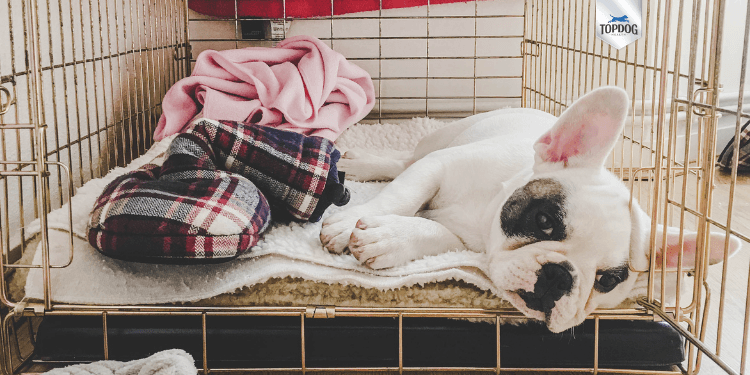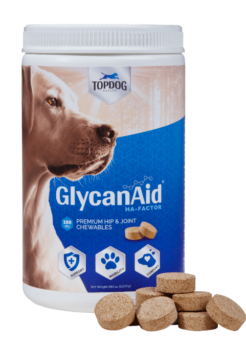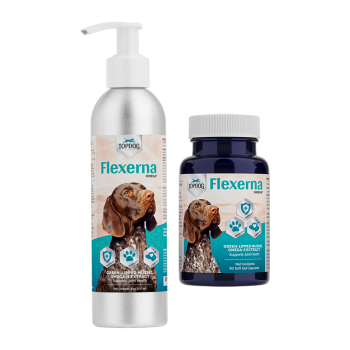Surviving Crate Rest for Dogs: Tips, Activities, Interactive Dog Toys
To you, crate rest for dogs may mean a relaxing, quiet environment where your pets can recover from surgery in peace. However, to dogs, crate rest can seem like one unending stretch of boredom in a very small world. Your job is to not only keep your dog comfortable and safe during his crate rest period but also to keep him entertained.
Keeping your dog mentally stimulated helps decrease dog boredom, release pent-up energy, increase confidence, and keep the memory sharp. It also strengthens your bond while giving your dog the feeling of having accomplished something. That can go a long way when your pet is spending his recovery period in a crate.
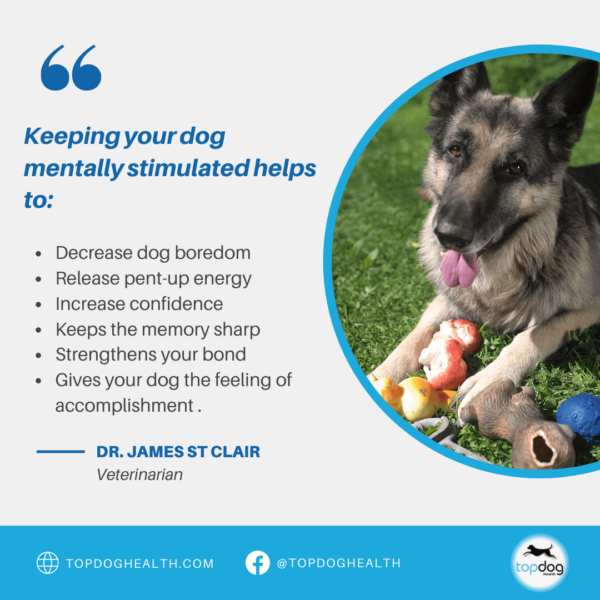
Crate Rest Comfort
Before you even begin to introduce interactive toys and activities to your dog, you want to make sure his crate environment provides adequate space and accommodations. If possible, introduce your dog to the crate well before his surgery so he’s already comfortable with the idea.
Choose a crate size that’s big enough for your dog. Dogs need to be able to freely stand, sit, stretch, change positions, eat and lie down fully extended. If your dog is too big for even the largest dog crates, you may want to consider creating a recovery room instead.
Cover the crate’s base with a non-slip mat, and then cover the mat with comfortable bedding. The ideal dog crate will have an area for sleeping and an area for the food and water bowl.
Create a Daily Routine
One of the best things you can do for your recovering dog is to set up a regular daily routine. Establish consistent times for feeding, outdoor bathroom breaks, playtime, and downtime for rest. Creating a routine can alleviate dog boredom while helping your dog feel secure. He’ll learn what to expect and when to expect it, giving him something to look forward to every day.
Activities for Dogs During Crate Rest
Although you want to keep your dog entertained, you don’t want to get him too excited. If your dog gets wound up at the sound of a clicker, for example, use verbal praise or food as a reward instead. Use a quiet voice during activities, keeping your movements slow and deliberate. Delivering food rewards directly to his mouth limits the movement he needs to make to receive them.
If you don’t want to overload your dog with treats during his recovery, you can use portions of his daily food ration as a reward.
Adapt activities as needed to accommodate your dog’s specific injury and activity level during recovery. Start easy and slow, with the least amount of movement needed. Gradually increase distance, distractions, and other elements as your dog continue to get stronger and more mobile.
Many activities during crate rest for dogs double as training sessions. You’re training your dog to learn and use a new skill. When that’s the case, you can apply the following sequence:
- Lure your dog into the desired behavior with a treat
- Repeat five to 10 times with the treat until he masters it
- Substitute a verbal command for the treat
- Reward your dog with the treat after he successfully follows the verbal command
Don’t hold the treat by the dog’s nose while you’re issuing the verbal command. That’s a surefire way to ensure the verbal command is the last thing on your dog’s mind, and the treat by his nose is the first.
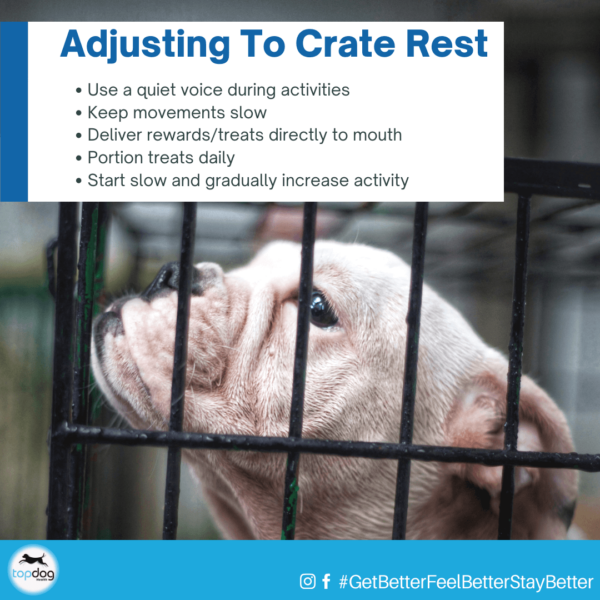
Activity: Head Down
-
Goal: Get your dog to put his head down on the floor
While your dog is on his belly with his head raised, place a treat far enough in front of him that he has to stretch his neck and place his chin on the ground. Release the treat with praise when he assumes the desired position.
Once he’s mastered the move with the treat, add the verbal command of “head down.” Reward with praise and a treat once his head is in the proper position.
Activity: Bone or Toy?
-
Goal: Get your dog to discriminate between two objects.
Gather up two items, such as a dog bone and a dog toy. Hold the bone in front of your dog, repeating the word “bone” while encouraging him to touch the bone with his paw as you say the word. Reward him for doing so. Repeat the process until your dog automatically puts his paw on the bone when you say the word “bone.”
Repeat the same process for the toy.
Place both the bone and toy in front of him, within reach of his paws. Decide which object you want him to touch, and say the word that corresponds with that object. Reward him for choosing the correct object, or touching the bone when you say “bone” and the toy when you say “toy.” Continue the game as desired, randomly switching the order of the objects throughout.
Activity: Bob Your Head
-
Goal: Get your dog to bob his head up and down.
Guide your dog into a head-bobbing action by moving a treat up and down in front of him. His head will bob as he follows the treat with his nose. Reward with praise and delivery of the treat.
Add a verbal cue, such as the phrase “head bob,” as you guide your dog to perform the head-bobbing action with the treat in front of his nose. Reward his successful performance. Continue to repeat the process, gradually reducing the need to guide him with a treat in front of his nose to perform the action on command. Continue to reward his success.
Activity: Interactive Dog Toys
Another way to beat dog boredom during recovery is with interactive dog toys. Rotating the toys gives your dog a different toy every day to keep interest high. Ideal toys during crate rest for dogs include:
- Food-dispensing toys, such as durable chew toys filled with kibble or with treat pockets
- Maze or puzzle-type toys that double as feeders
- Cardboard boxes and tubes you can fill with food, folding over the edges for a greater challenge
- Empty water bottles filled with kibble
Don’t forget you can use your dog’s daily food rations as rewards and toy-filler to avoid overeating and weight gain while in recovery.
With a comfortable crate environment, a daily routine, interactive toys, and activities, your dog may gain a new perspective on crate rest. You’ll not only beat dog boredom, but you may also come to truly enjoy the quiet bonding time as your dog gets stronger every day.
To help improve your dog’s strength and healing even further, consider adding a quality supplement from TopDog Health & Rehabilitation that specifically aligns with your dog’s needs.
Recommended Products:
You Might Also Be Interested In:
- Why Is My Dog Licking Excessively After Surgery?
- Can My Dog Sleep With A Cone On?
- There’s A Bump on My Dog’s Surgery Incisions… Now What?
- 6 Tips to Help Your Dog’s Surgical Wounds Heal Faster
- My Dog Isn’t Pooping After Orthopedic Surgery
- E-collars, Cones, and Alternatives
- When Can I Take My Dog’s E-collar Off?
- Getting Your Dog to Eat After Surgery
- Non-Toxic Ways To Remove Bandage Glue From Your Dog’s Fur
- Pet Proofing Your House in the Days, Weeks, and Months After Surgery
- 10 Ways to Keep Your Dog’s Brain Busy After Surgery
- Caring For Your Dog After Orthopedic Surgery: What Your Vet Is Not Telling You


